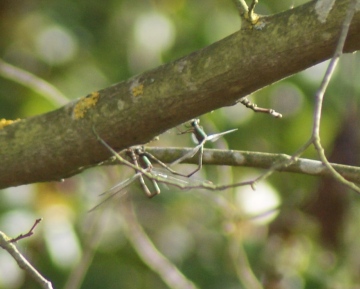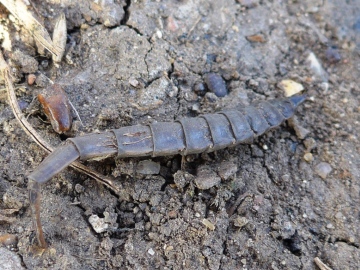Your Forum
The weblog below is for naturalists to use to report interesting sightings, ask questions, report on field meetings and generally post pictures and any information or questions generally relevant in some way to the wildlife and geology of Essex. You will need to register and be logged-on to post to the forum, and you need to upload pictures first, for use in posts. Find out more
|
Wed 22nd October 2014 22:08 by Mary Smith some thoughts
If a lot of insects are uncertain when to mate and lay eggs, we can expect other life forms to have similar difficulties. This spring, I found lots of plants in flower that had never stopped through the mild wet winter, and many annuals were bushy and very large, as they too had been growing all winter. If insects are also not knowing what to do when, all the rest of the animals of all kinds will be having problems too. And if it is like this in UK, then what about the rest of Europe? What about the rest of the world? The increase of chaotic weather systems is a part of global warming, of course, and the effects are being felt worldwide. But 'warming' sounds pleasant, something to look forward to, but we really should call it global heating, which sounds a lot less comfortable and a lot more scary. Keep watching the insects and the plants, and look for larger changes too. I find it all very unsettling. Wed 22nd October 2014 19:09 by Robert Smith Willow Emerald damselflies  Sunday 19th October was a very mild October day, plenty of sunshine, if a little windy. So a spot of autumn perch fishing was in order at Sandford Mill near Chelmsford. I chose a spot on the canal section, just by a hump-back bridge, and on the opposite bank was an Elm sapling. Occasionally, I noticed the odd damselfly being blown around in the wind, which I thought was unusual as I hadn't seen any for many weeks. So I thought they might have been a notable species, particularly as there was a mating pair. I eventually spotted them resting on the elm branches and managed to get some record shots from the opposite bank about 20' away.
Sunday 19th October was a very mild October day, plenty of sunshine, if a little windy. So a spot of autumn perch fishing was in order at Sandford Mill near Chelmsford. I chose a spot on the canal section, just by a hump-back bridge, and on the opposite bank was an Elm sapling. Occasionally, I noticed the odd damselfly being blown around in the wind, which I thought was unusual as I hadn't seen any for many weeks. So I thought they might have been a notable species, particularly as there was a mating pair. I eventually spotted them resting on the elm branches and managed to get some record shots from the opposite bank about 20' away.
After a bit of internet searching and help from Ted Benton, they turned out to be Willow Emerald damselflies, perhaps not that unusual on this river, but there were at least 4 of them and my photographs revealed the pair to be engaged in ovipositing. Like the Willow, the Elm tree has soft bark, that this damselfly needs, in which to lays their eggs, provided that the branches are overhanging the water. The larvae stay within the egg over winter and then hatch out in spring, falling to the water. The life-cycle is very quick, as they reach maturity in late summer/autumn. My internet searching also revealed that this species has recently been seen at Rainham Marshes for the first time, and also a single specimen in Hertfordshire. Mon 13th October 2014 19:27 by Stephen Rolls Footman
Probably a long shot but have you considered a Male Four-spotted Footman?. Sun 12th October 2014 20:05 by Graham Smith Footman
Peter - there has been a spate of records this autumn of species that do not usually produce 2nd broods. In my garden at Ingatestone I have caught Buff Ermine, Least Carpet, Heart & Dart and Common Footman in the past 2-3 weeks, all well out of season, and there have been reports of several other species on the Moth Group emails. It is doubtful whether isolated out of season records refer to a genuine second brood but they may be an indication that these species are about to produce one in the near future. A few records may simply refer to odd individuals from the first brood emerging very late. The reverse sometimes occurs in the spring with individuals emerging much earlier than usual, perhaps because they found a particularly warm spot in which to pupate. However, despite what our late, unlamented Environment Secretary may believe the times they are a changing, the climate among them, and these out of season records may possibly relate to this, Sun 12th October 2014 15:40 by Peter Pyke Footman sp
Hi all caught a footman sp in my MV trap last night, it looks good for Eilema depressa Buff Footman but no mention anywhere of a 2nd brood. Ideas please. Ta Pete. Sat 4th October 2014 14:43 by Graham Smith Mystery Insect
Does anyone know what kind of creature this is? We found it in the middle of a field at Blue House Farm last week.
At first I thought that it was a water beetle larva that had somehow attached itself to the fleece of a sheep drinking in the ditch nearby and had been dumped accidentally in the grass. However, it has no legs and the rigid exoskeleton means that it only has limited movement. Thus I imagine that it must be some form of pupa but what of I have no idea We tried releasing it in the water but it obviously could not swim so we placed it in a crevice on the bank on the grounds that the most likely pupation site would be underground. |
Archives: May 2020Aug 2019 Jan 2019 Sep 2018 Jul 2016 Oct 2015 Jul 2015 May 2015 Apr 2015 Mar 2015 Feb 2015 Jan 2015 Dec 2014 Oct 2014 Sep 2014 Aug 2014 Jul 2014 May 2014 Apr 2014 Mar 2014 Feb 2014 Jan 2014 Dec 2013 Nov 2013 Sep 2013 Aug 2013 Jul 2013 Jun 2013 May 2013 Apr 2013 Mar 2013 Feb 2013 Jan 2013 Dec 2012 Nov 2012 Oct 2012 Sep 2012 Aug 2012 Jul 2012 Jun 2012 May 2012 Apr 2012 Mar 2012 Feb 2012 Jan 2012 Dec 2011 Nov 2011 Oct 2011 Sep 2011 Aug 2011 Jul 2011 Jun 2011 May 2011 Apr 2011 Mar 2011 Feb 2011 Jan 2011 Dec 2010 Nov 2010 Oct 2010 Sep 2010 Aug 2010 Jul 2010 Jun 2010 May 2010 Apr 2010 Mar 2010 Feb 2010 Nov 2009 Oct 2009 Aug 2009 Jul 2009 Jun 2009 May 2009 Apr 2009 Mar 2009 Feb 2009 Jan 2009 Nov 2008 Oct 2008 Sep 2008 Aug 2008 Jul 2008 Jun 2008 May 2008 Apr 2008 Mar 2008 Feb 2008 Jan 2008 Dec 2007 Nov 2007 current posts |


















